“Don’t it always seem to go that you don’t know what you’ve got ’til it’s gone. They paved paradise, put up a parking lot.” Joni Mitchell, Big Yellow Taxi.
We see it everywhere – half empty parking lots, parking spaces along streets that sit empty much of the time. It’s so normal that we don’t even notice it. Yet, each of these parking spaces extracts a real financial, physical, and mental cost from each of us and our community. Many cities across the US have recognized this and started making changes. Cupertino is not one of them. We are still very much a car and asphalt centric city. If we care about our well-being, our mental and physical health and that of our children, we need to change our thinking to be more people centric and put human beings, not cars, at the center of our city planning.
Parking Spaces Harm Our Health
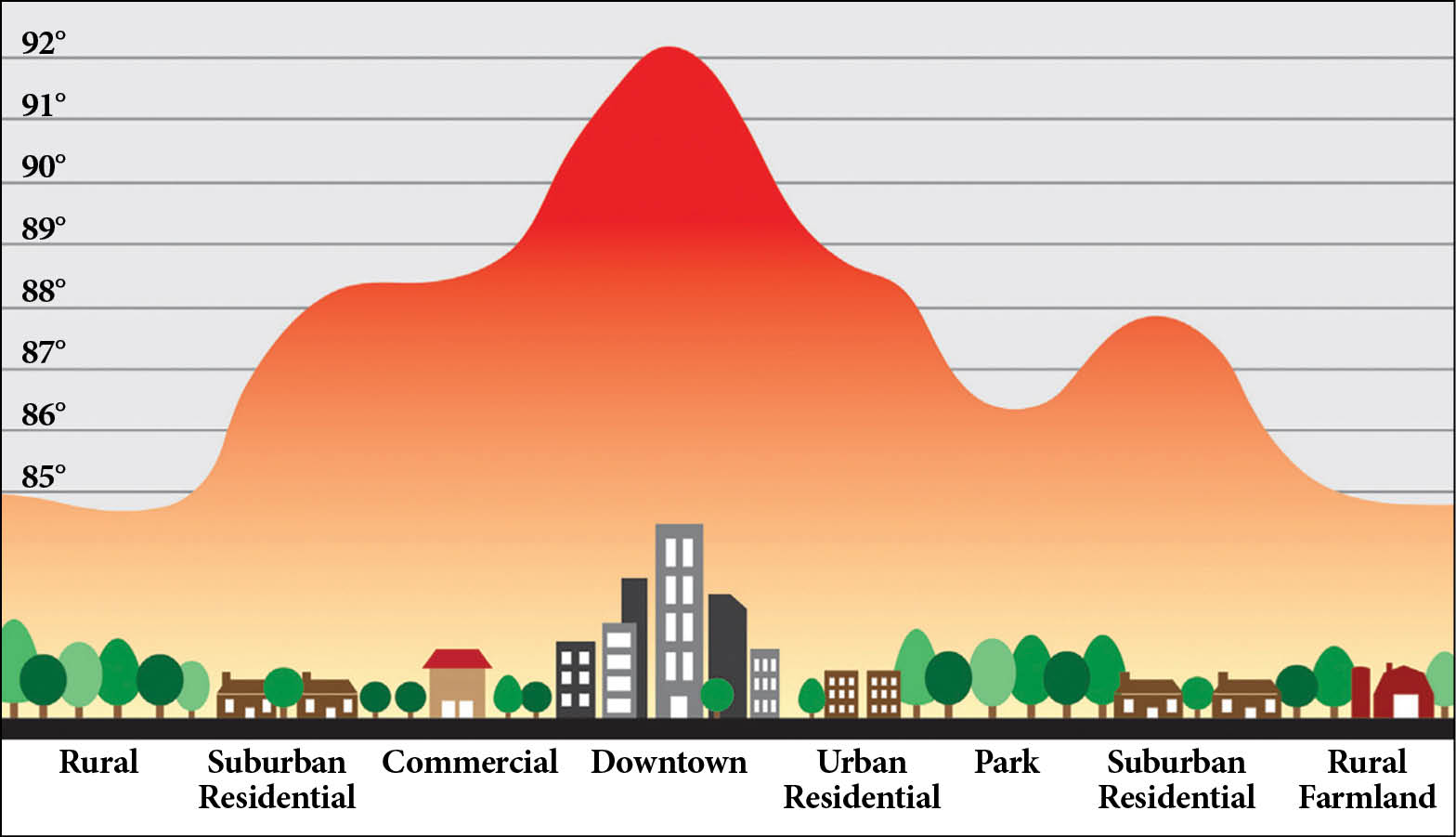
The Heat Island Effect of asphalt and concrete hard surfaces raises city temperatures by several degrees
When exposed to solar rays, asphalt emits harmful air pollutants. As the temperature rises into the 80s and 90s, road asphalt could release up to 300% more harmful emissions, according to research published in the journal Science Advances¹. While the science on the harmfulness of the absolute level of pollutants is not settled, this projected increase in emissions as temperatures rise is concerning.
Asphalt also creates the Heat Island Effect², which means that hard surfaces of streets, parking lots, and parking spaces, absorb, then release more of the heat from the sun to create hotter and more dangerous ambient air temperature. While trees, creeks, and green spaces absorb some of that heat, they can’t offset the impact of the large amount of asphalt and concrete in our city. As a result, on average, daytime temperatures in urban areas are about 1–7°F higher than temperatures in outlying areas and nighttime temperatures are about 2-5°F higher.
This increase in air pollutants and temperature could create unhealthy conditions, especially for our children and seniors.
Parking Spaces Harm Our Environment
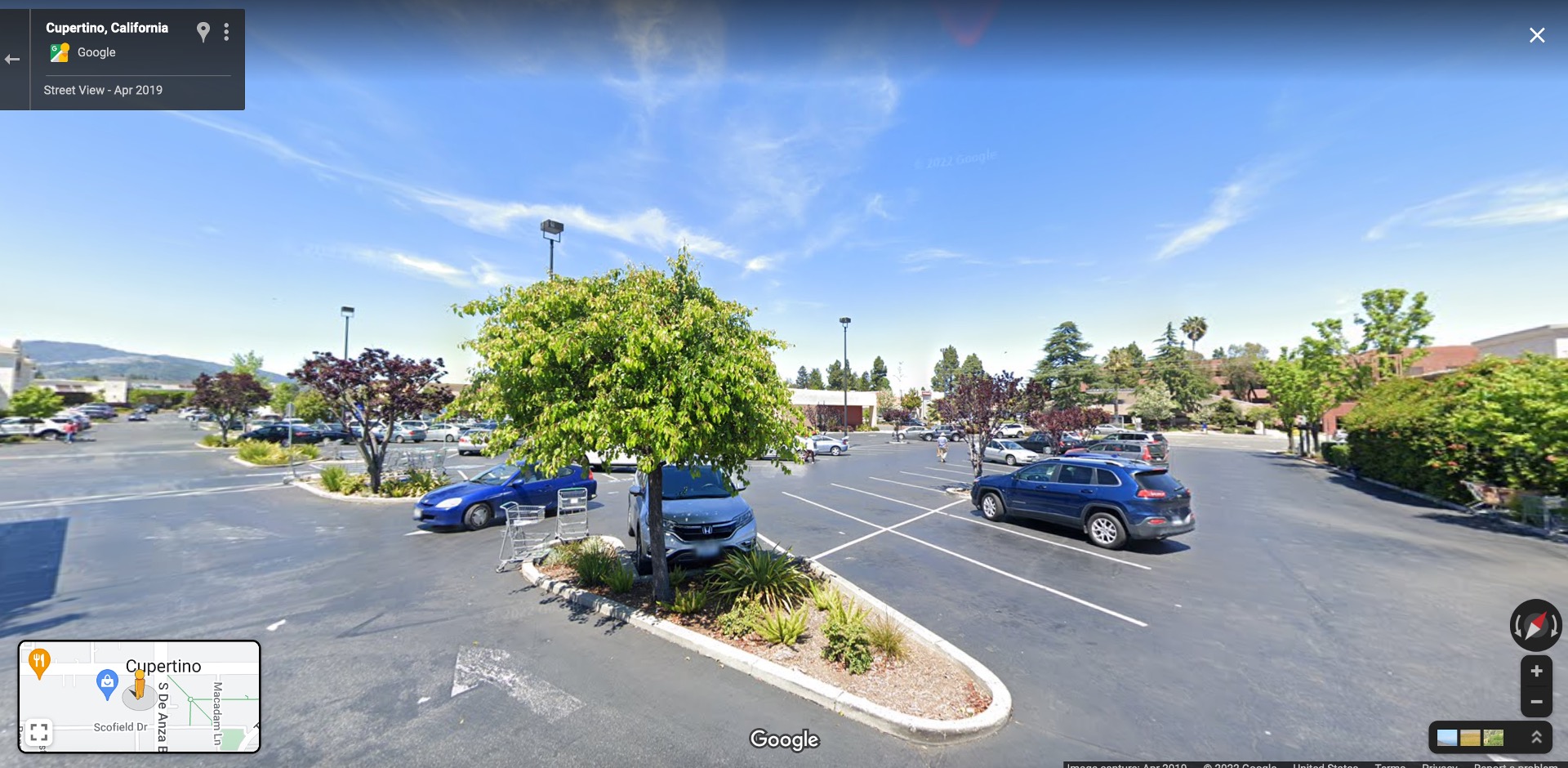
A half-empty parking lot in the Cupertino Crossroads Shopping Center
Parking contributes to greenhouse gases like carbon dioxide, methane and nitrous oxide. A study by civil engineers at the University of Berkeley³ developed a lifecycle estimate of the environmental cost of building parking infrastructure – the energy consumption and emissions of greenhouse gases, CO, SO2, NOX, VOC (volatile organic compounds), and PM10 (PM: particulate matter) from raw material extraction, transport, asphalt and concrete production, and placement (including direct, indirect, and supply chain processes) of space construction and maintenance. They then added this to the lifecycle of automobiles to calculate how much more energy consumption and greenhouse gas emissions were generated per kilometer traveled. They found that the environmental cost of parking spaces can raise the amount of carbon dioxide emitted per mile by as much as 10 percent for an average car. And, when calculated over the lifetime of a vehicle, the amount of other gases like sulfur dioxide can rise by as much as 25 percent and the amount of soot as much as 90 percent. Sulfur dioxide and soot are both harmful to humans and are associated with things like acid rain and respiratory illnesses.
Another severe environmental problem caused by parking lots is water pollutionª. Because parking lots accumulate a lot of pollutants (such as oil, grease, and heavy metals), a major environmental issue is the runoff of these into our creeks, underground water tables, and the bay.
Parking Minimums Harm Development
A 2020 study reported by Strong Towns* found that it costs $50,000 to build a parking space and $100,000 to create an underground parking space in Sunnyvale. If parking requirements were decreased by 50% in Sunnyvale, the freed-up space for businesses could provide over 3,000 more jobs in the area. The historic downtown Murphy Street was built before automobiles became a centric part of building regulations. If the area were to be rebuilt with today’s parking minimum requirements, at least four to thirteen times as much parking would need to be installed. Right now, Murphy Street contains about a quarter-million square feet of retail and 266 parking spaces.
In Cupertino, a new single-family home must come with four parking spaces. A duplex must provide six parking spaces. This is a huge unnecessary expense for homeowners and builders which creates large areas of concrete and asphalt hard surfaces in residential streets. Commercial buildings are saddled with such onerous minimum parking requirements that the buildings are dwarfed by the vast stretches of parking spaces around them. Parking lots are the single biggest land use in any city. They are the blackhole of city infrastructure development.
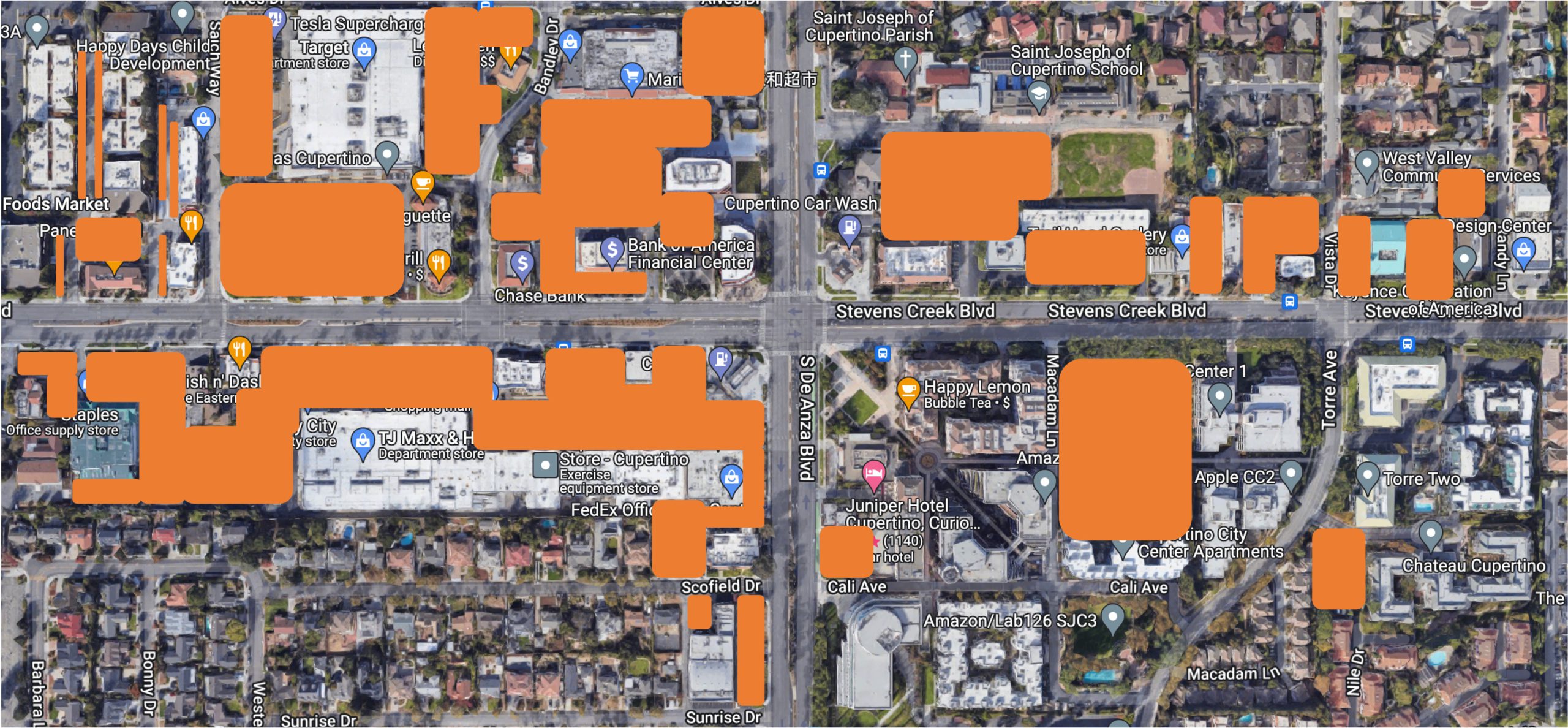
The parking lots, in orange, take up a much bigger space than the buildings themselves
Parking lots also increase infrastructure costs massively. If the Sprouts in the Crossroads Shopping Center requires a wide parking lot, the developer has to run water, sewer, storm water, electrical, and gas lines hundreds of feet across that parking lot to arrive at the store. Multiply that by all the stores, office buildings, restaurants, and apartment complexes in Cupertino and it becomes clear that this imposes a staggering cost of millions of unnecessary dollars on all development.
This appetite for parking lots, parking garages and parking spaces is insatiable. Yet, more and more parking does not make Cupertino a happier and happier city. In fact, the more parking we add, the less happy we are.
The city is proposing to add a massive 200-parking space 3-story parking garage at the Cupertino Library and City Hall as part of an $80 million project to rebuild City Hall, in the middle of a predominantly residential neighborhood. Will it make the residents in that area happier to be staring at a large parking garage instead of greenery and trees?
Un-Pave Parking Lots and Put Up a Paradise
The easiest way to transform a parking lot into something that improves our health, improves our city, and improves our environment is to put in a park. In Dallas, Santa Monica, Chicago, Savannah, San Francisco, and many other cities across the US, parking lots and parking spaces are being turned into parks and plazas. Studies have shown that parks with greenery improve both public health and property values. In a study, Trust for Public Land found that buildings next to a park are typically 15% more valuable than the same kind of building a few blocks away. Parks are an asset, while parking lots are a liability. Both from an economic and health perspective, it makes sense to replace Cupertino’s unused or under-used parking lots and parking spaces with pocket parks, mini-gardens, and parklets.
In 2019, a 3.2 acre parking lot in the heart of downtown Dallas was transformed into the Pacific Plaza Park, creating a green oasis in the middle of the city.
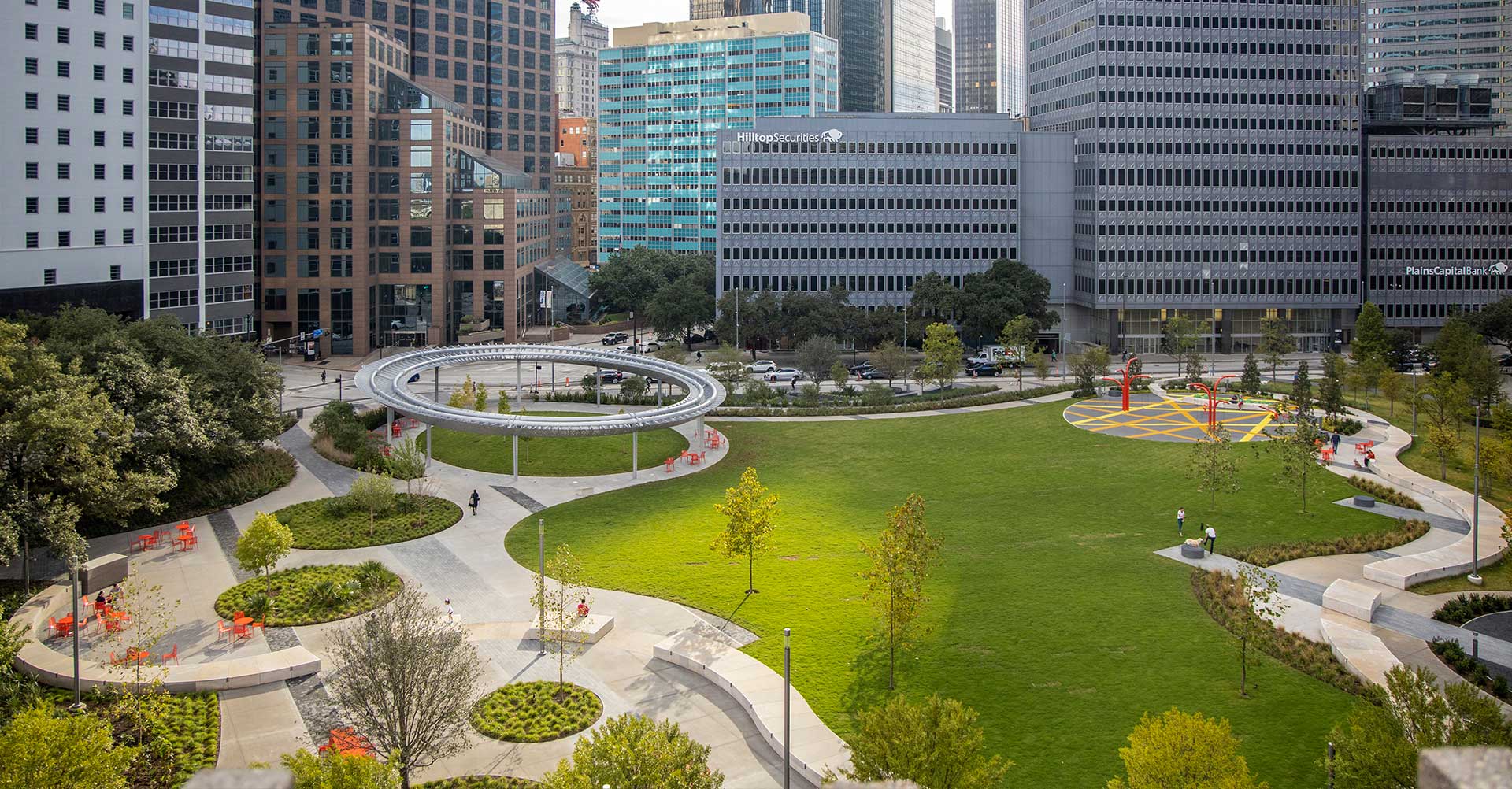
The Pacific Park Plaza in Dallas used to be a parking lot
Many cities like Portland and San Francisco are converting parking spaces to parklets or pocket parks. They provide a pleasant green space to socialize and relax and are easy to put in at a low cost anywhere there is a parking space. Frequently spaced parklets make it easier for seniors, families with small children, and residents with mobility challenges to go out walking, get some exercise and fresh air, and meet other community members.

Pocket parks and parking spaces converted to mini-parks
Parking lots can also be repurposed to provide public amenities like outdoor seating for restaurants and games for both kids and adults to engage in active socialization with one another.
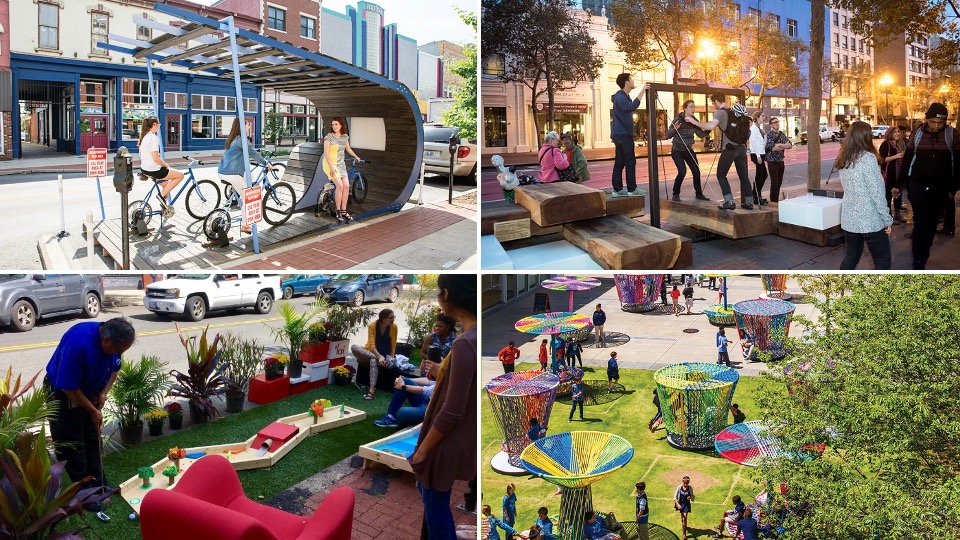
Mini-parks can encourage community interaction
Small changes such as these are easy to implement and make a big difference – planting more trees along streets, un-paving a parking space every ¼ mile, transforming an under-utilized parking lot into a pocket park oasis. They are inexpensive solutions with a big reaching impact in increased resident health and happiness, increased property values and a more thriving community.

At Fargo Forest Garden in Portland, 150 volunteers used sledgehammers and crowbars to pry up asphalt at an under-utilized parking lot. The site now has fruit trees, nut trees, berries, herbs, vegetables, and wildflowers (Image courtesy of Eric Rosewall/Depave).
How Do We Make This Happen?
We need a group of like-minded residents who are interested in working with the city to introduce these kinds of changes to Cupertino. If you’re interested in being part of this group, send us an email at walkbikecupertinofeedback@gmail.com.
Research shows that humans are happiest when they have access to a green space within a 1/4 mile distance of wherever they are in the city^. This is especially relevant for children and seniors who have more limited mobility.
Here’s a starting list of action items that would have a big impact.
- Reduce the city’s parking minimums
- Incentivize restaurants to transform some of their parking spaces into outdoor seating and mini-parks
- Incentivize commercial developments to convert part or all of their under-used or unused parking lots into pocket parks
- Plant more wide-canopy trees on city streets
- Convert selected parking spaces on streets into mini-parks
Sources
- https://www.science.org/doi/10.1126/sciadv.abb9785
- https://www.epa.gov/heatislands
- https://iopscience.iop.org/article/10.1088/1748-9326/5/3/034001
* https://www.strongtowns.org/journal/2022/3/1/we-require-way-too-much-parking
ª https://www.usgs.gov/news/estimates-areal-extent-us-parking-lots-now-available
